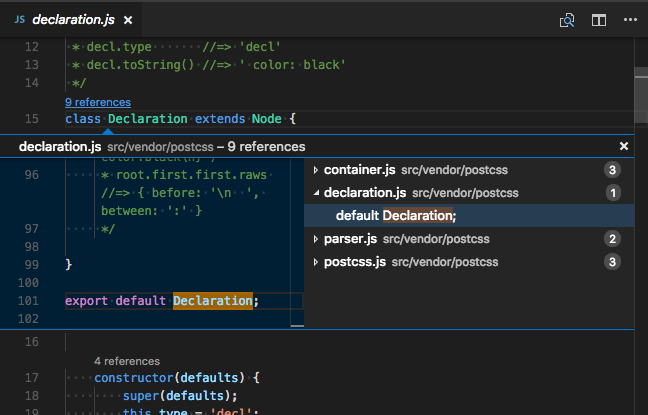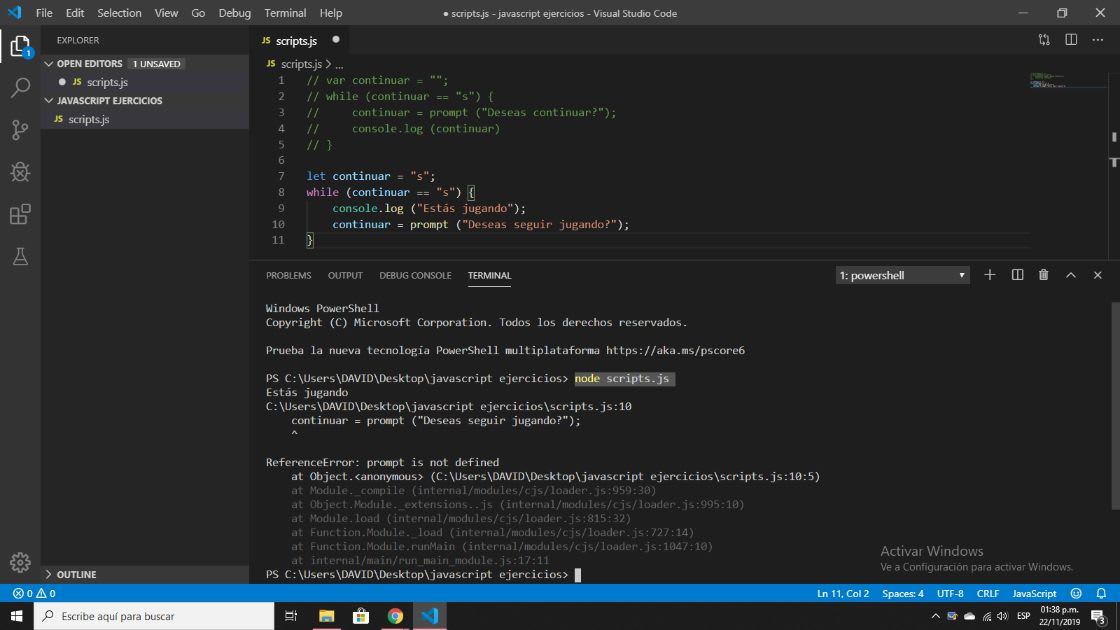VSCode extension to integrate JavaScript Standard Style into VSCode. We support JavaScript Semi-Standard Style too, if you prefer keeping the semicolon. JavaScript Standard Style with custom tweaks. JavaScript Getting Started Visual Studio 2019 Web Design JsDesign stunning websites with JavaScript, html5 and css3 or less or sass with visual studio.
A reference directive enables Visual Studio to establish a relationship between the script you are currently editing and other scripts. The reference directive lets you include a script file in the scripting context of the current script file. This enables IntelliSense to reference externally defined functions, types, and fields as you code. Visual Studio 2019 includes improved support for the Vue.js framework, which improves the development experience when creating an application with Vue.js, JavaScript. Install Node.js. Go to the node.js website by following the above link and click on the downloads.
-->JavaScript is a first-class language in Visual Studio. You can use most or all of the standard editing aids (code snippets, IntelliSense, and so on) when you write JavaScript code in the Visual Studio IDE. You can write JavaScript code for many application types and services.
Note
We have joined the community-wide effort to make MDN web docs the web's one-stop, premiere development resource, by redirecting all (500+ pages) of Microsoft's JavaScript API reference from docs.microsoft.com to their MDN counterparts. For details, see this announcement.
Visual Studio Javascript Intellisense
Support for ECMAScript 2015 (ES6) and beyond
Visual Studio now supports syntax for ECMAScript language updates such as ECMAScript 2015/2016.
What is ECMAScript 2015?
JavaScript is still evolving as a programming language and TC39 is the committee responsible for making updates.ECMAScript 2015 is an update to the JavaScript language that brings helpful new syntax and functionality. For a deep dive on ES6 features, check out this reference site.
In addition to support for ECMAScript 2015, Visual Studio also supports ECMAScript 2016 and will have support for future versions of ECMAScript as they are released. To keep up with TC39 and the latest changes in ECMAScript, follow their work on GitHub.
Transpile JavaScript
A common problem with JavaScript is that you want to use the latest ES6+ language features because they help you be more productive, but your runtime environments (often browsers) don't yet support these new features. This means that you either have to keep track of which browsers support what features (which can be tedious), or you need a way to convert your ES6+ code into a version that your target runtimes understand (usually ES5). Converting your code to a version that the runtime understands is commonly referred to as 'transpiling'.
One of the key features of TypeScript is the ability transpile ES6+ code to ES5 or ES3 so that you can write the code that makes you most productive, but still run your code on any platform. Because JavaScript in Visual Studio 2017 uses the same language service as TypeScript, it too can take advantage of ES6+ to ES5 transpilation.
Before transpilation can be set up, some understanding of the configuration options is required.TypeScript is configured via a tsconfig.json file.In the absence of such a file, some default values are used.For compatibility reasons, these defaults are different in a context where only JavaScript files (and optionally .d.ts files) are present.To compile JavaScript files, a tsconfig.json file must be added, and some of these options must be set explicitly.
The required settings for the tsconfig file are as follows:
allowJs: This value must be set totruefor JavaScript files to be recognized. The default value isfalse, because TypeScript compiles to JavaScript, and the compiler should not include files it just compiled.outDir: This value should be set to a location not included in the project, in order that the emitted JavaScript files are not detected and then included in the project (seeexclude).module: If using modules, this setting tells the compiler which module format the emitted code should use (for examplecommonjsfor Node, or bundlers such as Browserify).exclude: This setting states which folders not to include in the project.The output location, as well as non-project folders such asnode_modulesortemp, should be added to this setting.enableAutoDiscovery: This setting enables the automatic detection and download of definition files as outlined previously.compileOnSave: This setting tells the compiler if it should recompile any time a source file is saved in Visual Studio.typeAcquisition: This set of settings control the behavior of automatic type acquisition (further explain in this section)
In order to convert JavaScript files to CommonJS modules and place them in an ./out folder, you could use the following tsconfig.json file:
Visual Studio Javascript Tutorial
With the settings in place, if a source file (./app.js) existed and contained several ECMAScript 2015 language features as follows:
Visual Studio Javascript Bug
Then a file would be emitted to ./out/app.js targeting ECMAScript 5 (the default) that looks something like the following:
Better IntelliSense
JavaScript IntelliSense in Visual Studio 2017 will now display a lot more information on parameters and member lists. This new information is provided by the TypeScript language service, which uses static analysis behind the scenes to better understand your code. You can read more about the new IntelliSense experience and how it works here.
JSX syntax support
JavaScript in Visual Studio 2017 has rich support for the JSX syntax. JSX is a syntax set that allows HTML tags within JavaScript files.
How to open wps file. The following illustration shows a React component defined in the comps.tsx TypeScript file, and then this component being used from the app.jsx file, complete with IntelliSense for completions and documentation within the JSX expressions.You don't need TypeScript here, this specific example just happens to contain some TypeScript code as well.
Note
To convert the JSX syntax to React calls, the setting 'jsx': 'react' must be added to the compilerOptions in the tsconfig.json file.
The JavaScript file created at `./out/app.js' upon build would contain the code:
Configure your JavaScript project
The language service is powered by static analysis, which means it analyzes your source code without actually executing it in order to return IntelliSense results and provide other editing features.Therefore, the larger the quantity and size of files that are included your project context, the more memory and CPU will be used during analysis.Because of this, there are a few default assumptions that are made about your project shape:

package.jsonandbower.jsonlist dependencies used by your project and by default are included in Automatic Type Acquisition (ATA)- A top level
node_modulesfolder contains library source code and its contents are excluded from the project context by default - Every other
.js,.jsx,.ts, and.tsxfile is possibly one of your own source files and must be included in project context
In most cases, you will be able to just open your project and have great experience using the default project configuration. However, in projects that are large or have different folder structures, it may be desirable to further configure the language service to better focus only on your own source files.
Override defaults

package.jsonandbower.jsonlist dependencies used by your project and by default are included in Automatic Type Acquisition (ATA)- A top level
node_modulesfolder contains library source code and its contents are excluded from the project context by default - Every other
.js,.jsx,.ts, and.tsxfile is possibly one of your own source files and must be included in project context
In most cases, you will be able to just open your project and have great experience using the default project configuration. However, in projects that are large or have different folder structures, it may be desirable to further configure the language service to better focus only on your own source files.
Override defaults
You can override the default configuration by adding a tsconfig.json file to your project root.A tsconfig.json has several different options that can manipulate your project context.A few of them are listed below, but for a full set of all options available, see the schema store.
Important tsconfig.json options
Example project configuration
Given a project with the following setup:
- project's source files are in
wwwroot/js - project's lib files are in
wwwroot/lib bootstrap,jquery,jquery-validation, andjquery-validation-unobtrusiveare listed in thebower.jsonkendo-uihas been manually added to the lib folder
You could use the following tsconfig.json to make sure the language service only analyzes your source files in the js folder, but still fetches and uses .d.ts files for the libraries in your lib folder.
Troubleshooting The JavaScript language service has been disabled for the following project(s)
When you open a JavaScript project that has a very large amount of content, you might get a message that reads 'The JavaScript language service has been disabled for the following project(s)'. The most common reason for having a very large amount of JavaScript source is due to including libraries with source code that exceeds a 20MB project limit.
A simple way to optimize your project is to add a tsconfig.json file in your project root to let the language service know which files are safe to ignore. Use the sample below to exclude the most common directories where libraries are stored:
Add more directories as you see fit. Some other examples include 'vendor' or 'wwwroot/lib' directories.
Note
Visual Studio Javascript Code
The compiler property disableSizeLimit can be used as well to disable the 20MB check limit. Take special precautions when using this property because disabling the limit might crash the language service.
Notable Changes from Visual Studio 2015
As Visual Studio 2017 features a completely new language service, there are a few behaviors that will be different or absent from the previous experience.The most notable changes are the replacement of VSDoc with JSDoc, the removal of custom .intellisense.js extensions, and limited IntelliSense for specific code patterns.
No more /// or _references.js
Previously it was fairly complicated to understand at any given moment which files were in your IntelliSense scope. Sometimes it was desirable to have all your files in scope and other times it wasn't, and this led to complex configurations involving manual reference management. Going forward you no longer need to think about reference management and so you don't need triple slash references comments or _references.js files.
See the JavaScript IntelliSense page for more info on how IntelliSense works.
VSDoc
XML documentation comments, sometimes referred to as VSDocs, could previously be used to decorate your source code with additional data that would be used to buff up IntelliSense results.VSDoc is no longer supported in favor of JSDoc which is easier to write and the accepted standard for JavaScript.
.intellisense.js extensions
Previously, you could author IntelliSense extensions which would allow you to add custom completion results for third-party libraries.These extensions were fairly difficult to write and installing and referencing them was cumbersome, so going forward the new language service won't support these files.As an easier alternative, you can write a TypeScript definition file to provide the same IntelliSense benefits as the old .intellisense.js extensions.You can learn more about declaration (.d.ts) file authoring here.
Unsupported patterns
Because the new language service is powered by static analysis rather than an execution engine (read this issue for information of the differences), there are a few JavaScript patterns that no longer can be detected.The most common pattern is the 'expando' pattern.Currently the language service cannot provide IntelliSense on objects that have properties tacked on after declaration.For example:
You can get around this by declaring the properties during object creation:
You can also add a JSDoc comment as follows:

